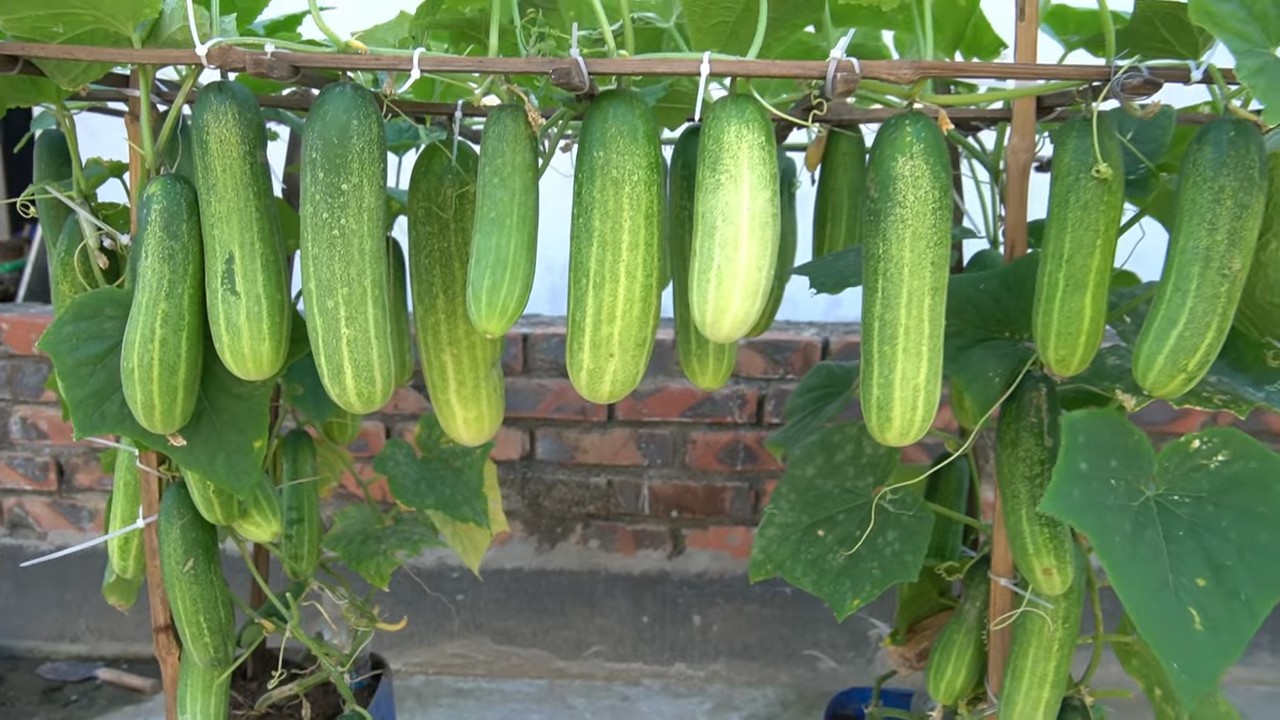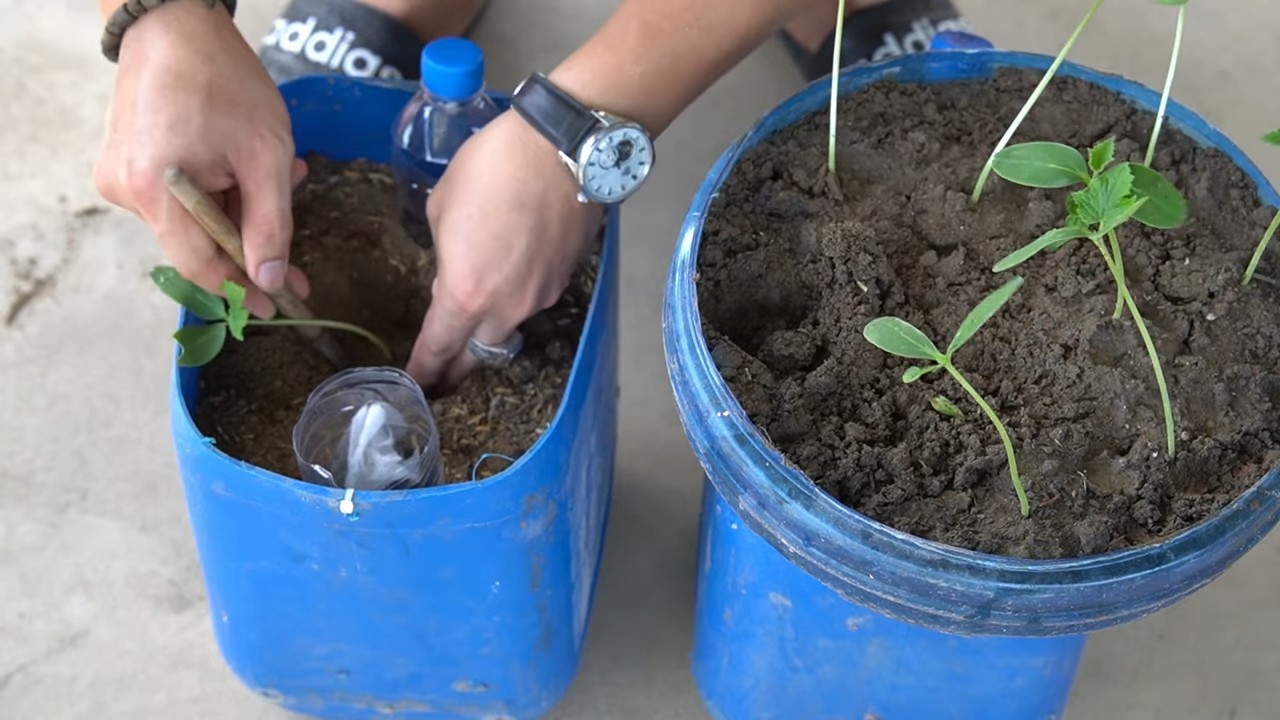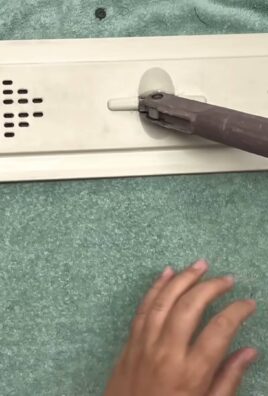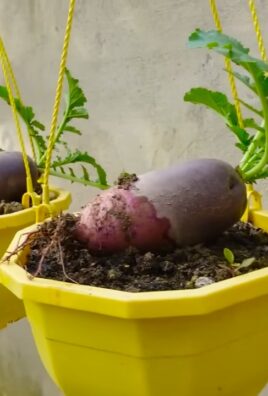Cucumbers in pots? Absolutely! Imagine stepping onto your balcony or into your small garden and plucking a crisp, refreshing cucumber, grown entirely by your own hand. Sounds idyllic, right? Well, it’s more achievable than you might think, even without acres of land. For centuries, container gardening has allowed people to cultivate food and beauty in limited spaces. From the hanging gardens of Babylon to the humble window boxes of today, the desire to nurture life in our immediate surroundings is deeply ingrained.
But why should you consider growing cucumbers in pots? Let’s face it, fresh, homegrown produce tastes infinitely better than anything you can buy at the store. Plus, you have complete control over what goes into your food, avoiding harmful pesticides and ensuring the highest quality. This DIY guide is packed with simple, effective tricks and hacks that will empower you to successfully grow cucumbers in pots, regardless of your experience level. I’m here to show you that with a little know-how, you can enjoy a bountiful harvest of delicious cucumbers, right at your doorstep. Get ready to roll up your sleeves and discover the joy of homegrown goodness!

Growing Cucumbers in Pots: A Comprehensive DIY Guide
Hey there, fellow gardening enthusiasts! I’m so excited to share my tried-and-true method for growing delicious, crisp cucumbers right in pots. Forget needing a huge garden – with a little know-how, you can enjoy homegrown cucumbers even if you only have a balcony or patio. Let’s dive in!
Why Grow Cucumbers in Pots?
Honestly, there are so many reasons! Here are a few of my favorites:
* Space Saving: Perfect for small spaces like apartments, balconies, and patios.
* Mobility: You can easily move your cucumber plants to follow the sun or protect them from harsh weather.
* Pest Control: It’s easier to monitor and manage pests when your plants are contained in pots.
* Soil Control: You have complete control over the soil composition, ensuring your cucumbers get the nutrients they need.
* Early Harvest: Starting cucumbers indoors in pots can give you a head start on the growing season.
Choosing the Right Cucumber Variety
Not all cucumbers are created equal, especially when it comes to container gardening. Here’s what I look for:
* Bush Varieties: These are compact and well-suited for pots. Look for varieties like ‘Bush Champion,’ ‘Spacemaster,’ ‘Salad Bush,’ or ‘Patio Snacker.’ These are bred to be smaller and more manageable.
* Dwarf Varieties: Similar to bush varieties, dwarf cucumbers are naturally smaller and require less space.
* Pickling Cucumbers: While some pickling varieties can be vining, there are bush types available. If you love pickles, this is a great option!
* Avoid Vining Varieties (Unless You Have a Large Trellis): While you *can* grow vining cucumbers in pots, they require a large trellis and a lot of space. If you’re limited on space, stick to bush or dwarf varieties.
Materials You’ll Need
Before we get started, let’s gather everything we need. This will make the process much smoother.
* Cucumber Seeds or Seedlings: Choose your preferred variety as discussed above.
* Large Pots (5-10 Gallon): The bigger, the better! Cucumbers need plenty of room for their roots to grow. I recommend at least a 5-gallon pot, but a 10-gallon pot is even better.
* High-Quality Potting Mix: Avoid using garden soil, as it can compact in pots. Use a well-draining potting mix specifically formulated for containers.
* Trellis or Support System: Even bush varieties benefit from some support. A small trellis, tomato cage, or even sturdy stakes will work.
* Slow-Release Fertilizer: This will provide your cucumbers with a steady supply of nutrients throughout the growing season.
* Watering Can or Hose: For regular watering.
* Gardening Gloves: To protect your hands.
* Optional:
* Seed starting tray and dome (if starting from seed indoors).
* Heat mat (if starting from seed indoors).
* Liquid fertilizer (for supplemental feeding).
* Mulch (to help retain moisture).
Step-by-Step Instructions: Planting Your Cucumbers
Okay, let’s get our hands dirty! Here’s how I plant my cucumbers in pots:
1. Starting from Seed (Optional)
If you’re starting from seed, begin about 3-4 weeks before the last expected frost.
1. Fill Seed Starting Tray: Fill your seed starting tray with a seed starting mix.
2. Sow Seeds: Plant 2-3 cucumber seeds per cell, about ½ inch deep.
3. Water Gently: Water the soil gently until it’s moist but not soggy.
4. Cover with Dome: Cover the tray with a humidity dome to create a warm, moist environment.
5. Provide Warmth: Place the tray on a heat mat or in a warm location. Cucumber seeds germinate best at temperatures between 70-80°F (21-27°C).
6. Provide Light: Once the seeds germinate (usually within 5-10 days), remove the dome and provide plenty of light. A sunny windowsill or grow light will work.
7. Thin Seedlings: Once the seedlings have their first true leaves, thin them to one strong seedling per cell.
2. Preparing the Pot
Whether you’re transplanting seedlings or planting seeds directly in the pot, this step is crucial.
1. Choose the Right Pot: Make sure your pot is at least 5 gallons in size and has drainage holes.
2. Add Potting Mix: Fill the pot with high-quality potting mix, leaving about 2-3 inches of space at the top.
3. Incorporate Slow-Release Fertilizer: Mix a slow-release fertilizer into the top few inches of the potting mix according to the package directions. This will provide your cucumbers with a steady supply of nutrients.
4. Water the Soil: Water the potting mix thoroughly until water drains out of the bottom of the pot. This will help settle the soil and ensure it’s evenly moist.
3. Planting the Cucumbers
Now for the fun part!
1. For Seedlings: Gently remove the cucumber seedling from its cell in the seed starting tray. Be careful not to damage the roots.
2. Dig a Hole: Dig a hole in the center of the pot that’s large enough to accommodate the seedling’s root ball.
3. Plant the Seedling: Place the seedling in the hole and gently backfill with potting mix. Make sure the top of the root ball is level with the surrounding soil.
4. For Seeds: Plant 2-3 cucumber seeds directly in the center of the pot, about ½ inch deep.
5. Water Gently: Water the newly planted seedling or seeds gently.
6. Add Support: Install your trellis, tomato cage, or stakes now to avoid disturbing the roots later.
Caring for Your Potted Cucumbers
Once your cucumbers are planted, it’s important to provide them with the care they need to thrive.
1. Watering
Cucumbers need consistent moisture, especially when they’re fruiting.
* Water Deeply: Water deeply whenever the top inch of soil feels dry to the touch.
* Avoid Overwatering: Don’t let the pot sit in standing water, as this can lead to root rot.
* Water in the Morning: Water in the morning to allow the foliage to dry before nightfall, which can help prevent fungal diseases.
2. Sunlight
Cucumbers need at least 6-8 hours of sunlight per day.
* Choose a Sunny Location: Place your potted cucumbers in a location that receives plenty of sunlight.
* Rotate the Pots: Rotate the pots occasionally to ensure all sides of the plant receive equal sunlight.
3. Fertilizing
Even with slow-release fertilizer, your cucumbers may need supplemental feeding.
* Liquid Fertilizer: Feed your cucumbers with a liquid fertilizer every 2-3 weeks, following the package directions. I like to use a balanced fertilizer or one that’s slightly higher in phosphorus and potassium to promote flowering and fruiting.
* Compost Tea: You can also use compost tea as a natural fertilizer.
4. Pruning and Training
Pruning and training can help improve air circulation and encourage fruit production.
* Remove Suckers: Remove any suckers (small shoots that grow from the base of the plant) to encourage the plant to focus its energy on fruit production.
* Train Vines: If you’re growing a vining variety, train the vines to climb the trellis or support system.
* Pinch Back Tips: Pinch back the tips of the vines to encourage branching and more fruit production.
5. Pest and Disease Control
Keep an eye out for common cucumber pests and diseases.
* Common Pests: Aphids, cucumber beetles, squash bugs, and spider mites are common cucumber pests.
* Common Diseases: Powdery mildew, downy mildew, and bacterial wilt are common cucumber diseases.
* Prevention:
* Inspect your plants regularly for signs of pests or diseases.
* Provide good air circulation by spacing plants properly and pruning as needed.
* Water in the morning to allow the foliage to dry before nightfall.
* Use organic pest control methods, such as insecticidal soap or neem oil, to control pests.
* Use a copper fungicide to prevent fungal diseases.
Harvesting Your Cucumbers
The moment you’ve been waiting for!
* Harvest Regularly: Harvest your cucumbers regularly, as this will encourage the plant to produce more fruit.
* Harvest at the Right Size

Conclusion
So, there you have it! Growing cucumbers in pots isn’t just a gardening trend; it’s a game-changer for anyone with limited space, a desire for fresh, homegrown produce, or simply a love for the satisfying crunch of a perfectly ripe cucumber. We’ve walked you through the essentials, from selecting the right variety and pot size to providing the necessary support and care. But why is this DIY trick a must-try?
Firstly, the sheer convenience is undeniable. No sprawling garden required! You can enjoy the taste of summer right on your balcony, patio, or even a sunny windowsill. Secondly, growing cucumbers in pots gives you unparalleled control over the growing environment. You can easily move your plants to chase the sun, protect them from unexpected frosts, or shield them from pests. This level of control often translates to a healthier, more productive harvest.
And let’s not forget the sheer joy of nurturing a plant from seed to fruit. There’s something incredibly rewarding about watching those tiny seedlings sprout and transform into vibrant, cucumber-laden vines. It’s a connection to nature that’s both therapeutic and delicious.
But the best part? The possibilities are endless! Feel free to experiment with different cucumber varieties. Bush cucumbers are particularly well-suited for containers, but you can also try vining varieties with proper trellising. Consider adding companion plants like marigolds or basil to deter pests and attract pollinators. You can even try succession planting, sowing new seeds every few weeks to ensure a continuous harvest throughout the growing season.
For a spicy kick, try growing pickling cucumbers and making your own homemade pickles. Or, for a refreshing twist, experiment with lemon cucumbers, known for their mild, slightly sweet flavor. If you’re feeling adventurous, why not try growing Armenian cucumbers, also known as snake melons, which offer a unique, elongated shape and crisp texture?
Don’t be afraid to get creative with your container choices, too. While plastic pots are a practical option, terracotta pots can add a touch of rustic charm. Just remember to choose a pot that’s large enough to accommodate the mature plant and provide adequate drainage.
Ultimately, the success of your potted cucumber garden depends on your willingness to experiment and adapt. Pay attention to your plants’ needs, adjust your watering and fertilizing schedule as necessary, and don’t be discouraged by occasional setbacks. Gardening is a learning process, and every mistake is an opportunity to grow (pun intended!).
We wholeheartedly encourage you to give this DIY trick a try. It’s a fun, rewarding, and delicious way to bring the taste of summer to your home, no matter how limited your space may be. And most importantly, we want to hear about your experience! Share your photos, tips, and stories with us in the comments below. Let’s create a community of potted cucumber enthusiasts and inspire others to discover the joys of homegrown produce. What are you waiting for? Grab a pot, some seeds, and get growing! Let’s see those beautiful, bountiful cucumbers in pots!
Frequently Asked Questions (FAQ)
What is the best type of cucumber to grow in a pot?
While many cucumber varieties can be grown in pots, bush varieties are generally the most suitable due to their compact size and shorter vines. These include varieties like ‘Bush Champion,’ ‘Spacemaster,’ and ‘Salad Bush.’ Vining varieties, such as ‘Burpless Beauty’ or ‘Marketmore 76,’ can also be grown in containers, but they require a sturdy trellis or support system to climb. Consider the available space and your preference when selecting a variety. If you have limited space, stick with bush varieties. If you’re willing to provide a trellis, vining varieties can be just as rewarding.
How big should the pot be for growing cucumbers?
A pot that is at least 12 inches in diameter and 12 inches deep is recommended for growing cucumbers. Larger pots, such as 5-gallon containers or larger, are even better, as they provide more room for the roots to grow and help retain moisture. The size of the pot will also depend on the variety of cucumber you choose. Bush varieties can thrive in slightly smaller pots, while vining varieties will benefit from larger containers. Ensure the pot has drainage holes to prevent waterlogging.
What kind of soil should I use for growing cucumbers in pots?
Use a well-draining potting mix that is rich in organic matter. Avoid using garden soil, as it can become compacted in containers and hinder drainage. A good potting mix will provide the necessary nutrients and aeration for healthy root growth. You can also amend the potting mix with compost or other organic materials to improve its fertility and water-holding capacity. Look for potting mixes specifically formulated for vegetables or containers.
How often should I water my potted cucumber plants?
Cucumbers are thirsty plants and require consistent watering, especially when grown in pots. Water deeply whenever the top inch of soil feels dry to the touch. During hot, dry weather, you may need to water your plants daily or even twice a day. Avoid overwatering, as this can lead to root rot. Check the drainage holes to ensure that excess water is draining properly. Mulching around the base of the plants can help retain moisture and reduce the need for frequent watering.
How much sunlight do cucumbers need?
Cucumbers need at least 6-8 hours of direct sunlight per day to thrive. Choose a sunny location for your potted cucumber plants, such as a south-facing balcony or patio. If you don’t have a spot that receives full sun, you can supplement with grow lights. Insufficient sunlight can result in stunted growth, reduced fruit production, and pale, weak plants.
Do I need to fertilize my potted cucumber plants?
Yes, cucumbers are heavy feeders and benefit from regular fertilization. Use a balanced fertilizer, such as a 10-10-10 or 5-5-5, every 2-3 weeks. You can also use a liquid fertilizer diluted according to the package instructions. Avoid over-fertilizing, as this can burn the roots. Organic fertilizers, such as compost tea or fish emulsion, are also excellent options.
How do I support my cucumber plants in pots?
Vining cucumber varieties require a trellis or other support system to climb. You can use a bamboo trellis, a tomato cage, or even a sturdy fence. Bush varieties may not need support, but providing a small stake or cage can help keep the plants upright and prevent the fruits from touching the soil. Ensure the support system is strong enough to handle the weight of the mature plant and its fruits.
How do I deal with pests and diseases on my potted cucumber plants?
Regularly inspect your plants for signs of pests or diseases. Common cucumber pests include aphids, squash bugs, and cucumber beetles. You can control these pests with insecticidal soap, neem oil, or by handpicking them off the plants. Common cucumber diseases include powdery mildew and downy mildew. Prevent these diseases by providing good air circulation, avoiding overhead watering, and using disease-resistant varieties. If you notice signs of disease, treat the plants with a fungicide.
When should I harvest my cucumbers?
Harvest cucumbers when they are the desired size and color. The exact size and color will depend on the variety. Generally, cucumbers are ready to harvest when they are firm, smooth, and have a deep green color. Overripe cucumbers can become bitter and seedy. Harvest regularly to encourage continued fruit production. Use a sharp knife or scissors to cut the cucumbers from the vine, leaving a small stem attached.
Can I grow cucumbers indoors in pots?
Yes, you can grow cucumbers indoors in pots, but it requires more effort and attention. You’ll need to provide adequate light, either through a sunny window or with grow lights. You’ll also need to pollinate the flowers manually, as there will be no bees or other pollinators indoors. Use a small paintbrush to transfer pollen from the male flowers to the female flowers. Indoor cucumbers may not be as productive as outdoor cucumbers, but they can still provide a rewarding harvest.




Leave a Comment